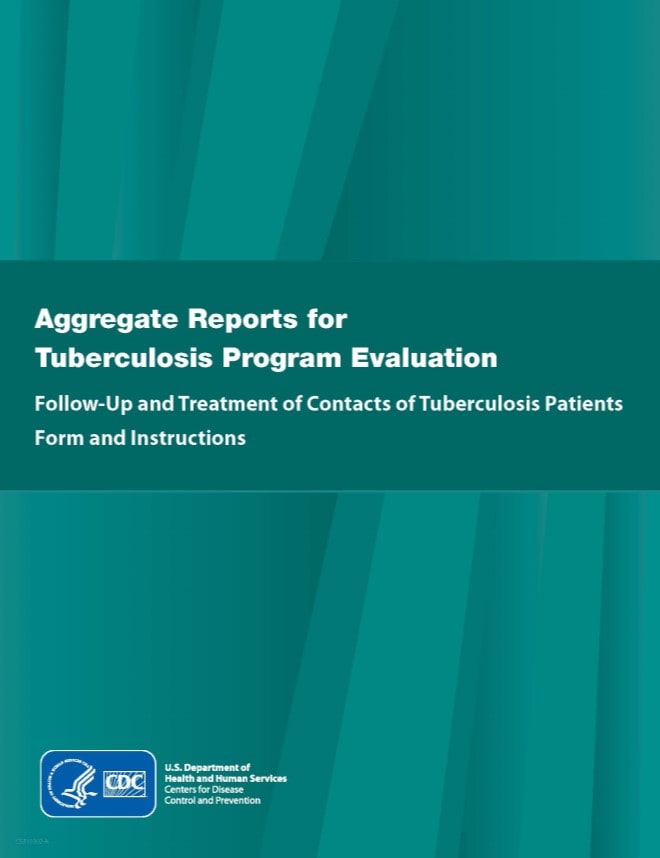About
ARPE provide national summaries of tuberculosis (TB) prevention activities carried out by TB programs. Activities summarized in the report include follow-up and treatment of contacts of TB patients and targeted testing of groups at higher risk of latent TB infection or progression from latent tuberculosis infection to TB disease.

When and How to Submit ARPE Data
Aggregate Reports for Tuberculosis Program Evaluation (ARPE) contact follow-up and targeted testing data are submitted using the National Tuberculosis Indicators Project (NTIP) web-based tool. Only state and local TB program staff who are designated by the State Surveillance Administrator have been granted access to NTIP.
When to submit ARPE data
- Submit preliminary and final data into NTIP by March 31 of each year.
- Enter the preliminary report into NTIP by March 31 after the cohort year.
- Submit the final report, including completion of therapy data, to CDC no later than the following March 31 (one year after submission of the preliminary report).
Examples:
- By March 31, 2025, submit the preliminary report for cohort year 2024 and the final report for cohort year 2023.
- By March 31, 2026, submit the preliminary report for cohort year 2025 and the final report for cohort year 2024.
More information about how to search, submit, upload, or export ARPE forms are listed in the NTIP Online Help Webpage. This webpage is only accessible to TB Program staff who have been granted access to NTIP.
Need access to the NTIP web-based tool?
Follow-Up and Treatment of Contacts of TB Patients Form
Use this form to provide an annual summary about:
- Identifying and evaluating the contacts of TB cases, and
- Treating the contacts who test positive for latent TB infection.
TB programs submit data for contacts of the following three TB case types:
- Sputum Smear Positive TB Cases, defined as cases that meet all of the following criteria:
- Inclusion in the overall surveillance count,
- A disease site in the respiratory system including the airways, and
- A positive acid-fast bacillus (AFB) sputum-smear result, whether or not any culture result is positive.
- Inclusion in the overall surveillance count,
- Sputum Smear Negative Culture Positive TB Cases, defined as cases that meet all of the following criteria:
- Inclusion in the overall surveillance count,
- A disease site in the respiratory system including the airways,
- Negative AFB sputum smear results, and
- Sputum culture result positive for Mycobacterium tuberculosis.
- Inclusion in the overall surveillance count,
- Other TB Cases: This category includes contact investigations that were done because of any circumstances not included in the other two categories (for example, associate-contact or source-case investigations done because of TB in a child.) The number of contacts is counted, but the number of cases for investigation is not.
Contact investigation data are summarized annually in the Contact Investigations Report (ARPE Data) and the State and City TB Report.
The current guidance and instructions are available at the link below:
Targeted Testing and Treatment for Latent TB Infection Form
Use this form to provide an annual summary about targeted testing of groups that either:
- Have a high prevalence rate of latent TB infection or
- Have a high risk of progression to TB disease from Mycobacterium tuberculosis infection.
TB programs submit data for targeted testing activities in three categories:
- Project: Targeted testing projects for groups done at sites outside the health department, as determined for convenience or by the needs of the groups being tested.
- Individual: Targeted testing done one person at a time or by group but outside of testing projects, when testing is in accordance with national, state, or local guidelines for selecting persons who are at risk for TB and who are expected to be candidates for treatment if they have latent TB infection.
- Administrative: Targeted testing done when the testing is a low public health priority because the tested persons or groups are not at risk for TB and might not even be candidates for latent TB infection.
The targeted testing form includes submission of data by Medical or Population risk. Every person who is listed with latent TB infection should be classified as either Medical risk or Population risk, but not both. If a person can be counted in both categories, they should only be listed as Medical risk. If a person has no known medical risks, they should be counted under Population risk.
Funded TB programs with high TB incidence (defined as ≥150 cases per year) in their jurisdiction are required to submit targeted testing data for each calendar year (also known as a cohort year). Regardless of each jurisdiction's level of TB incidence, all TB programs are encouraged to submit this information to CDC each year.
Targeted testing data are summarized annually in the Targeted Testing Report (ARPE Data).
The current guidance and instructions are available at the link below:


